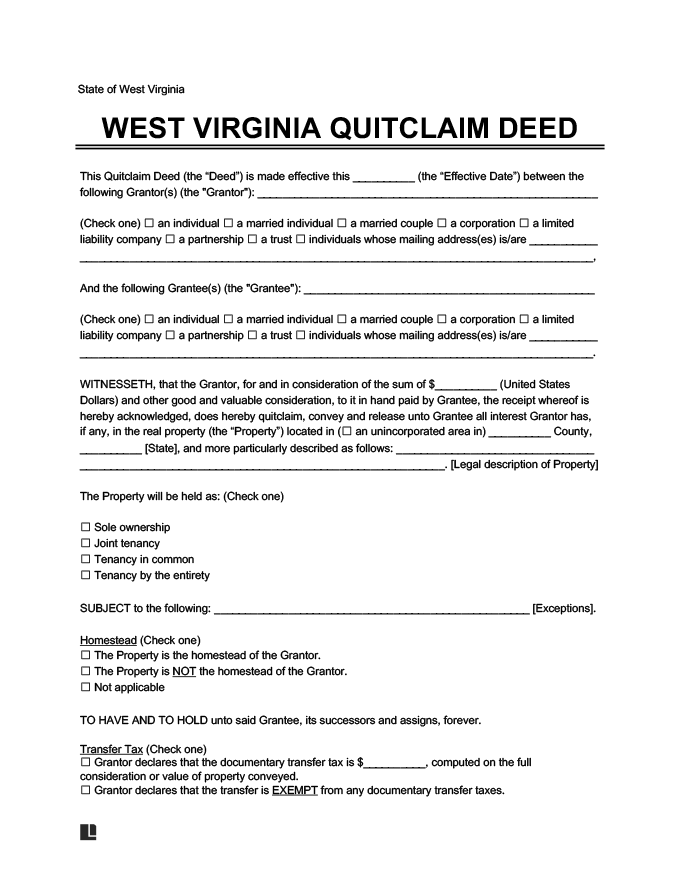West Virginians use quitclaim deeds to transfer a title, or ownership claim, in a property from a grantor to a grantee. Unlike other deeds, a quitclaim deed does not protect the grantee against title defects like an unpaid lien or mortgage, an error in an earlier deed affecting the title, or a third-party claim of ownership on the property.
Despite its limitations, a quitclaim deed is a popular option for parties with a high level of trust in one another to transfer property more quickly and easily. Read on to discover the requirements for these deeds so you remain in compliance with state regulations.
Legal Framework
The state provides laws surrounding deeds in W. Va. Code § 36-3. You can further explore this chapter to find the definition of a quitclaim deed in W. Va. Code § 36-3-7, which provides the specific language to incorporate.
Furthermore, W. Va. Code § 39-1 dictates the process for authenticating and recording a deed.
Legal Description
The quitclaim deed must include the property’s complete legal description, which is not the same as the property’s mailing address. You can find the legal description in previous deeds of the property, which you can locate in the county clerk’s office.
The legal description may contain the following information:
- Metes and bounds
- Lot and block
- References to the Public Land Survey System (PLSS)
Signing
A deed must be in writing and include the grantor’s signature (W. Va. Code § 36-1-3). According to W. Va. Code § 39-1-2, the grantor must sign before two witnesses. Alternatively, a notary public or an official under W. Va. Code § 39-1-3 can acknowledge the grantor’s signature to validate the deed.
Terminology
W. Va. Code § 36-3-7 provides that using the following phrase creates a quitclaim deed: “the said grantor releases to the said grantee all his claims upon the said lands.”
Words that have similar meanings can also create a quitclaim deed. In addition, a statutory deed form is present in W. Va. Code § 36-3-5, but using the form in that section is not necessary for the document to be legally binding.
Additional Documents
The grantor must complete and submit a Sales Listing Form (Form STC 12:39) when they file their quitclaim deed.
Additionally, W. Va. Code § 11-22-6 states that the grantor must submit a Declaration of Consideration or Value statement. They can ignore this requirement if the transaction is exempt from the excise tax.
Filing
W. Va. Code § 39-1-2 provides that the grantor should record the quitclaim deed with the West Virginia county clerk in the property’s county. The grantor must pay a $30 filing fee to the county clerk (W. Va. Code § 59-1-10).
Validity Requirements
W. Va. Code § 39-1-11 outlines some validity requirements for all deeds, including quitclaim deeds:
- The text should only be present on one side of the paper.
- The font should be no smaller than 10 points.
- Two font points should separate each line.
The state doesn’t offer specific guidelines for ink color, page margins, or legibility, but it’s wise to follow these general standards:
- Print the form in black ink and have all signatures appear in black or dark blue ink.
- Create a two-inch margin for the top of the quitclaim deed’s first page and a one-inch margin for all other margins (consult your county clerk’s office for specific requirements, if applicable).
- Ensure the document is legible enough to create intelligible copies and electronic reproductions.
Content Requirements
The content of your quitclaim deed must have the following information:
- Grantor and grantee’s names and addresses
- The date of conveyance, which is when the grantor signs the document
- The amount of money (or “consideration”), if any, that will facilitate the property transfer
- The property address and its county
- The legal description of the property
- The nature of ownership if the property is being transferred to more than one party
- An attached Sales Listing Form
- The grantor’s signature, acknowledged by either two witnesses or a notary public
Quitclaim Deeds vs. Other Property Transfer Methods
| Quitclaim Deed | Places the potential risk of title issues or flaws on the grantee. |
| General Warranty Deed | Keeps the potential risk of all title issues or flaws with the current owner (the grantor). |
| Special Warranty Deed | Splits the potential risk between the new owner and the previous one because the previous owner only promises to defend against claims rising from their ownership period. |
| Transfer on Death Deed | Transfers real estate when the owner dies; allows the owner to retain full rights during their lifetime. |
| Life Estate Deed | Similar to a transfer on death deed, but the owner relinquishes some rights during their lifetime to give them to remainder beneficiaries. |
